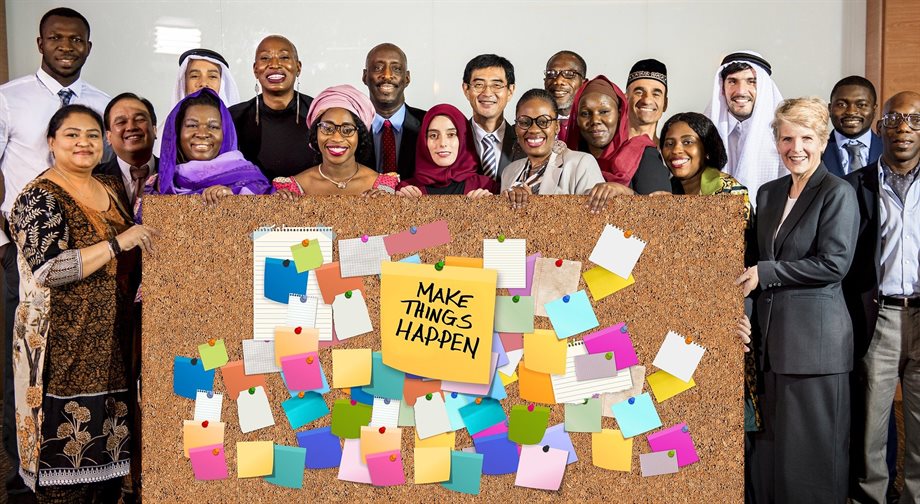Diverse teams make better decisions 87% of the time. Inclusion instantly activates existing gender, age and geographic diversity for better business decision making.

St Mary's has staff and students from diverse backgrounds. As part of our commitment to supporting and empowering staff and students of all backgrounds it is important that we encourage views from everybody as far as possible. As a Higher Education Institution, St Mary's also has an obligation to ensure diversity of thought and an openness to different points of view.
Working groups and committees, recruitment panels, staff surveys, and the change consultation process are core mechanisms for decision making at St Mary's. It is essential that representing diverse viewpoints, and creating an inclusive environment which encourages involvement in decision making, is considered a priority in these contexts.
By encouraging views from our diverse staff, we bring rich and different perspectives to decision making. This in turn creates a culture of diverse and inclusive decision making.
What can you do to bring diversity and inclusiveness to decision making? The hints and tips, under the different headings below, will help all staff to take steps to increase diversity and inclusiveness in the University and in decision making.
Established committees should engage in ongoing reflection on the make-up of the group, and identify perspectives that might be underrepresented. Particularly consider the topic(s) you are discussing, what impact there could be from an equality perspective, and which perspectives or experiences you might need in the group to better inform those discussions.
There are 9 protected characteristics in the Equality Act 2010 that committees/groups should pay particular attention to, but it is important to remember that this list is not exhaustive. Anything that marks an individual or group as 'different' can lead them to being excluded, intentionally or unintentionally. Being fully inclusive means considering the views of our diverse staff, and making room for different views, opinions and experiences.
The protected characteristics are:
- sex (gender)
- race
- age
- disability
- religion or belief
- gender reassignment
- pregnancy or maternity
- marriage and civil partnership
Notice the different personalities at the table, how can you encourage contribution from them all? Consider different approaches to reaching decisions e.g.
- Small group discussions using post-its and flipcharts to feedback.
- Thinking pairs, when thinking stalls, divide the group into pairs and give each person five minutes to think out loud and without interruption about the topic.
How can we ensure we recruit people from diverse backgrounds?
- Consider the makeup of the panel, is it diverse. Where possible you should always seek to have a panel that is diverse in terms of characteristics such as gender, age, ethnicity, nationality, and socio-economic background. This is not always possible, but is a good position to strive for. Be careful to not overburden certain staff members when including measures like this. It is not fair to expect someone to sit on almost every selection panel in your department, even if they are happy to do so.
- Be aware of unconscious bias, it affects everyone, no matter how progressive you think you are. This is why it is called unconscious bias, because even if your conscious mind has a series of progressive beliefs, your unconscious mind may not. Unconscious bias leads you to make judgements about people based on their appearance and key characteristics. Tackling this is about recognising your inbuilt prejudices and challenging them. It is also about challenging those on the same panel as you if they are inclined to decide on the basis of unconscious (or conscious) bias. Find out your implicit associations about race, gender, sexual orientation, and other topics through these tests compiled by Harvard University. You will need to register to take to the test.
- Think about how you can give people from under-represented groups a chance to impress you. This is called positive discrimination. We know that some groups are more likely to get a job interview when they may not actually be any better than other candidates. Therefore, there is nothing wrong with including selection measures such as positive discrimination to ‘level the playing field’, whilst making sure you get the best candidate for the job.
- For academic roles, consider whether a diversity of intellectual perspectives is an important to include on the panel.
Encourage all staff to complete the survey so we get feedback from all of our staff. This enables inclusive decision making on improvements that are made as a result of the surveys. What can you do?
- As a manger encourage all your staff to complete the survey – every view matters!
- Talk with your team about the importance of completing the survey.
Manage the wider impact of change on people. What can you do?
- Talk to your team about change early on and think about how you can involve them.
- Embrace the diversity of thought in your team, and the different ways people think, act, and innovate.
- Be inclusive and share information with all team members and consider how you can tap into the diversity in your team to make the change work.
- Be mindful that some staff may need more support than others through change.
- Encourage active participation from your team through frequent, planned opportunities to feedback.